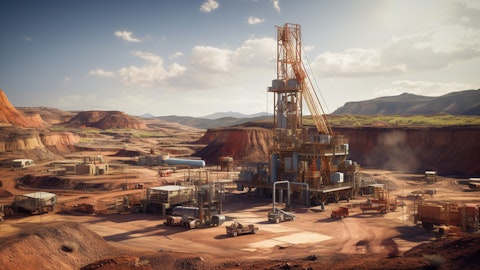Euan Gray: Yes, I think so. Byproducts, precious metals producers probably also have a similar elevated view. Us is take a balanced view on gold price, but we’re certainly constructive on that as well.
Tanya Jakusconek: Okay. And then, Euan, maybe just on. I know in your Investor Day, I think it was Paul that mentioned that you are looking at lithium potential transaction and other non-gold transactions. Can you just comment on where you are on that? Whether we’re still — those are in the pipeline and whether we can see those in 2024 or is the focus still gold ahead of these non-gold?
Jason O’Connell: Hi, Tanya. It’s Jason speaking. I would say the focus still is on gold. I think that’s where we spend the majority of our time. That said, there are a lot of opportunities in many different commodities right now. Lithium is one that is interesting to us, just given where we are in the price cycle. There’s obviously been a significant pullback in the lithium price, which has created a bit of a challenge for developers looking to finance new mines. And so there is, as a consequence, potentially a role there for us to play a part. And so it’s something that we’re spending time on, and we may be active this year. Just depends on the opportunities that are in front of us.
Tanya Jakusconek: And what size would those opportunities be in, Jason?
Jason O’Connell: It’s a range, I think probably the sweet spot for us would be 50 to maybe up to $300 million, $400 million if we did something very sizable.
Tanya Jakusconek: Okay. And my last question, if I could just on uranium. We’ve seen volatility in that space as well. Anything in terms of looking at uranium for you guys?
Jason O’Connell: We do look at uranium from time-to-time. There aren’t as many assets available for us to participate in. There’s a couple that we keep our eye on, but it’s not something that we’re spending a lot of time on recently, despite the change in commodity price.
Tanya Jakusconek: Okay, I appreciate that. I’ll leave it for someone else to ask questions and really appreciate you answering my questions. Thank you.
Jason O’Connell: Yes.
Operator: Your next question comes from John Tumazos from Very Independent Research. Please go ahead.
John Tumazos: Thank you very much. It’s always hard to figure out how to value things. Presumably, Franco, as you approach new transactions, values them at the spot gold price or today, 2,300-ish. And then you put a capitalization rate based on the mine life and quality, and maybe that would have been 8x or 10x revenue for a simple royalty, or adjusting for how much in the money a stream is. But gold stocks are actually a little bit lower, even though gold is higher. And now there’s the minimum tax rate, which equips your return a little bit. So is it fair to assume that given the valuation of gold stocks and the tax status not only in Franco, but your peers as well, that you’d be capitalizing revenue at a lower rate going forward than you might have a couple years ago? Also, interest rates are higher. That’s another factor. Excuse me.
Paul Brink: John, it’s Paul. A lot of things in there. Number one thing, anytime we’re looking at a property is as less so commodity prices, it’s more figuring out what are we comfortable is there, happy to pry, pay a fulsome price for what we’re comfortable will get produced, and then want to participate in the upside. And it’s really getting the calls right and being able to participate in the upside that generally has the greatest impact on our returns. So the vast majority of our work, though, is figuring out what are we comfortable we’ll get produced. Particularly when you’re looking at development projects. Sometimes our view is less than what you can see in reserves. Sometimes it’s far more. That’s by far the biggest determinant.
In terms of commodity prices, we’re trying to price deals in the context of the market. The trick is you don’t want to get caught when prices run up sharply in paying peak prices. And on the other hand, when the market turns down, that’s really where you want to get your deals done. You don’t want to get caught up using bear market prices, because you undervalue everything. So it’s, in a sense, it’s trying to take a longer-term view of prices regardless of where the market has moved to in the time. On your last comment, in terms of rates and how do we think about rates? We think of it as a bit of a competitive advantage. And the competitive advantage is we don’t have much debt. So with so many parties, their cost of capital is moving up and down with their cost of debt.
We don’t really have that. So we think it’s an advantage. We can do deals in the market. We can extend capital to people at a more consistent rate than other players over time. And so particularly when other folks are forced to use a higher cost of capital, we don’t have to. And I think that’s a bit of a competitive advantage.
John Tumazos: Thank you.
Operator: Your next question comes from Tanya Jakusconek from Scotiabank. Please go ahead.
Tanya Jakusconek: Good morning again. Sorry, I forgot to ask about Cobre Panama. I know Cosmos asked about it with the election happening on May 5th, but can you just review for us when do the parties actually then get into office? Are we talking, like, July-ish or thereabouts? And once they get into office, are we expecting more clarity? So maybe just a bit of timeframe for us on getting some news out on Cobre Panama?
Paul Brink: Tanya, you’re exactly right. Election is coming up now, but the actual official change of government will only happen in July. So that’s the first time that they could. They’re in a position of power. It doesn’t mean that you can’t have dialogue with them before that. But to your point, I don’t want to expect any news, any direction on Cobre until later in the summer.
Tanya Jakusconek: Okay, no that’s very helpful because we maybe I’ll be waiting Sunday night, and then Monday morning thinking something might be said. But probably realistically, it’s probably not until the end of the summer?





